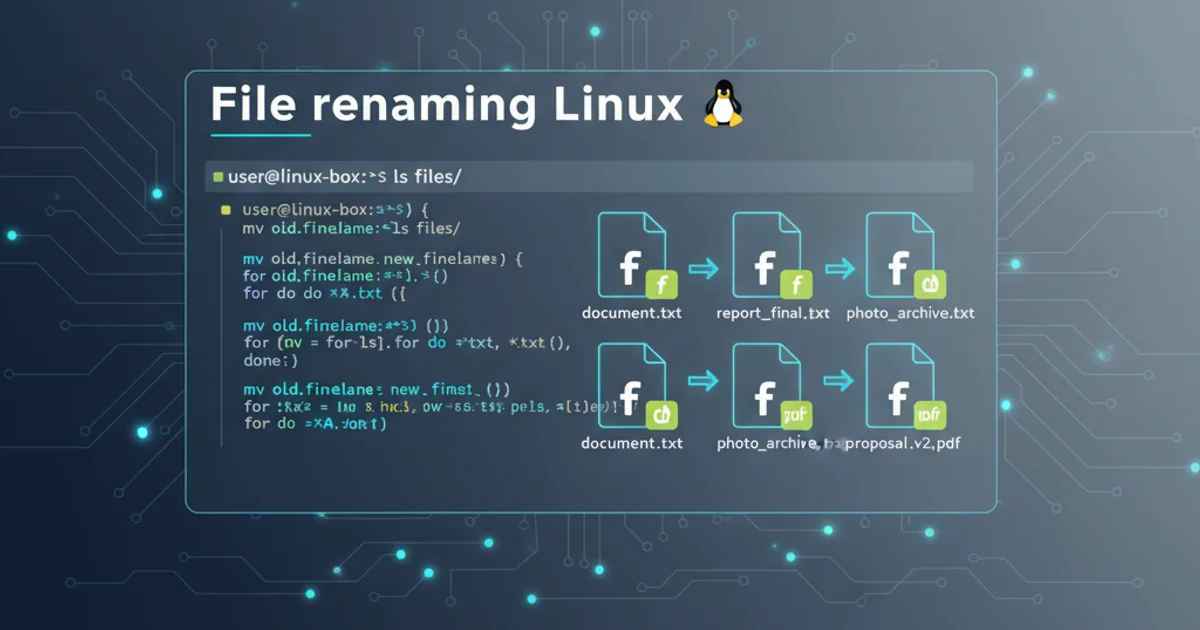File renaming Linux
Categories:
Mastering File Renaming in Linux: A Comprehensive Guide

Learn the essential commands and techniques for renaming files and directories in Linux, from simple renames to complex batch operations.
Renaming files and directories is a fundamental task in any operating system, and Linux offers a powerful set of tools to accomplish this with precision and flexibility. Whether you're dealing with a single file or need to perform complex batch renaming operations, understanding the mv and rename commands is crucial. This article will guide you through the various methods, best practices, and common pitfalls to ensure your file management is efficient and error-free.
The mv Command: Simple Renaming and Moving
The mv (move) command is the most basic and frequently used utility for renaming files and directories in Linux. While its primary function is to move files from one location to another, it can also rename a file or directory by moving it to a new name within the same directory. It's straightforward for one-off renaming tasks.
# Rename a single file
mv old_filename.txt new_filename.txt
# Rename a directory
mv old_directory_name new_directory_name
# Move and rename a file to a different directory
mv file.txt /path/to/new_directory/renamed_file.txt
Basic usage of the mv command for renaming.
mv. If a file with the new_filename already exists, mv will overwrite it by default without prompting, unless the -i (interactive) flag is used.The rename Command: Advanced Batch Renaming
For more complex renaming scenarios, especially when dealing with multiple files that follow a pattern, the rename command (also known as perl-rename or file-rename) is indispensable. This command uses Perl regular expressions to define sophisticated renaming rules, allowing for powerful batch operations. Note that the exact syntax and availability of rename can vary slightly between Linux distributions (e.g., Debian/Ubuntu vs. CentOS/Fedora).
flowchart TD
A[Start Batch Rename] --> B{Identify Target Files}
B --> C{Define Regex Pattern}
C --> D{Test Pattern (Optional)}
D --> E{Execute Rename Command}
E --> F[Files Renamed]Workflow for batch renaming using the rename command.
# Example 1: Change file extension from .jpeg to .jpg
rename 's/\.jpeg$/\.jpg/' *.jpeg
# Example 2: Convert spaces to underscores in filenames
rename 's/ /_/g' *
# Example 3: Convert filenames to lowercase
rename 'y/A-Z/a-z/' *
# Example 4: Remove a specific string from filenames
rename 's/old_prefix_//' *old_prefix_*.txt
Common rename command examples using Perl regular expressions.
rename command with the -n (no-op or dry run) option first to see what changes would be made without actually executing them. This prevents accidental data loss or incorrect renaming.Renaming with find and xargs for Recursive Operations
When you need to rename files across multiple subdirectories, combining find with xargs and mv or rename provides a robust solution. This allows you to locate files based on various criteria and then apply a renaming operation to them recursively.
# Find all .txt files in current directory and subdirectories and rename them to .text
find . -name "*.txt" -print0 | xargs -0 rename 's/\.txt$/\.text/'
# Find and rename files containing 'draft' to 'final' in their name
find . -type f -name "*draft*" -print0 | xargs -0 -I {} mv {} $(echo {} | sed 's/draft/final/')
Using find and xargs for recursive renaming.
-print0 and -0 options with find and xargs are crucial for handling filenames that contain spaces or special characters safely. They use a null character as a delimiter, preventing issues that arise from whitespace.